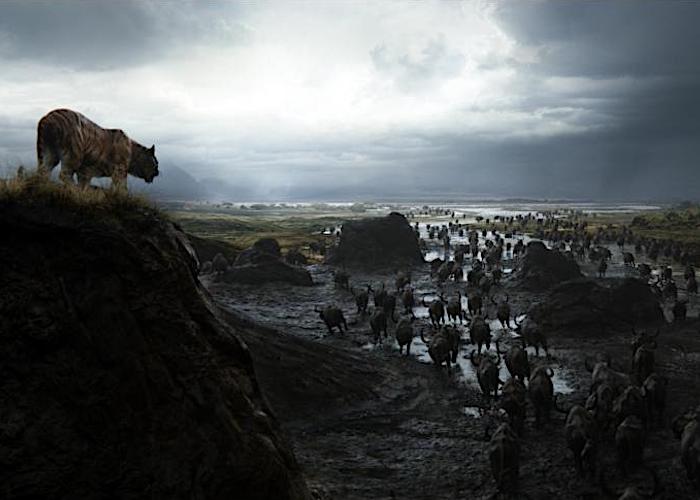
This may come as a surprise to some of you, but it is possible for a remake to actually turn out better than the original film. It’s far from a common experience, obviously, but it does happen. I swear. The latest example of this phenomenon is an unlikely surprise for dozens of reasons, but none of them change the outcome — Jon Favreau‘s big, CG/live-action hybrid reboot of Walt Disney’s The Jungle Book is a beautiful, exciting, and terrifically immersive experience that feels familiar while boldly declaring its own existence.
The story basics remain the same. Young Mowgli (Neel Sethi) was just a baby when fate left him alone and defenseless in the middle of the jungle. Bagheera (voice of Ben Kingsley), the black panther, takes pity on the man-cub and passes him off to the wolf pack to be raised as one of their own. Life finds a way until the much-feared tiger, Shere Khan (voice of Idris Elba), returns to the area and sets his carnivorous sights on the child. He warns the other jungle denizens that Mowgli is an intruder destined to become a man — and they all know that men bring destruction, death, and fire.
It’s decided that the boy will be better off back with his own kind, so Bagheera and a begrudging Mowgli set off for the nearest village. The journey sees Mowgli befriend a mildly selfish bear named Baloo (voice of Bill Murray) while also crossing paths with varying threats including a mesmerizing snake named Kaa (voice of Scarlett Johansson) and King Louie (voice of Christopher Walken), an over-sized orangutan who rules part of the jungle with an army of monkeys at his Col. Kurtz-infused command. Meanwhile, back at the wolf den, Shere Khan expresses his disappointment in the animals who sent Mowgli out of his reach.
“How many lives is a man-cub worth?” asks the tiger, and in many ways that becomes the central theme of Justin Marks‘ (Street Fighter: The Legend of Chun-Li) screenplay as Mowgli’s friends risk their own to help save his. That nod to sacrifice and friendship is present in the Disney original, but Marks adds some shades of grey that with any luck will encourage conversation among families. It’s not lightning that brings “the red flower” into the conflict here, it’s Mowgli, and destruction follows in his fiery wake. Shere Khan may be the villain of the piece, but his warning is a prescient truth about humanity’s lack of responsibility as stewards of the planet. As exciting as it is to see this play out though it’s not clear if the film itself wants to fully recognize the boy’s culpability — who am I kidding, the smug look on Mowgli’s face afterwards and his lack of apology make it pretty clear.
Still, these are adult concerns. The little ones will be oblivious as they instead fall in love — and rightly so — with the film’s gorgeous visuals, ridiculously life-like animal CG, and entertaining banter between Mowgli and his four-legged friends. We get some of Disney’s iconic images including Baloo and the boy floating down a gentle river on his back, beautifully silhouetted landscape shots, and a couple familiar songs. Murray brings a playful energy to his rendition of “The Bare Necessities,” while Walken turns a re-jiggered “I Wanna Be Like You” into an energetic, vaguely threatening ditty.
The latter is fun as a standalone bit, but King Louie himself is problematic in a few areas. Most notable is the issue of scale — the film clearly isn’t meant to be realistic, but an effort is made to capture the various animals as they appear in the wild. Louie, by contrast, is ginormous — think Mighty Joe Young’s older brother for a general idea — and it knocks you back a bit from this carefully-constructed rendition of jungle life. The inclusion of the song also feels a bit forced. We see Baloo as the kind of character who would sing a lazy song, but Louie’s musical outburst feels too manufactured and out of place.
The world of Favreau’s latest may be constructed from CG and materials from the Disney vault, but it’s one he imbues with real weight. There’s death here alongside decisions based as much on morality as survival, and Favreau ensures that the emotional/narrative value is paired with a tangible physicality. We feel the pull of gravity, we see the result of jungle living in Mowgli’s bruised and scratched skin, and we hear the symphony of wildlife, wind, and John Debney‘s rousing score. You’re a part of this world (regardless of whether or not you’re watching in 3-D).
The Jungle Book can be nit-picked by adult viewers, but minor criticisms aside this is a major step up for Disney’s life-action arm and the best of the big redos of their own classics. It’s terrific entertainment whether or not you have a family by your side.
The Upside: Beautiful and impressive visuals; weighty in both narrative and animation; exciting, fun, and often intense; strong message on family and friends
The Downside: King Louie-related issues; doesn’t follow through on more mature ideas; CG less effective when moving quickly through the jungle
Related Topics: Bill Murray, Jon Favreau
